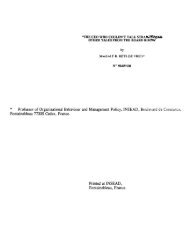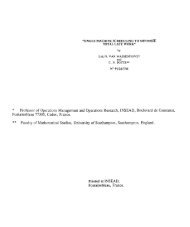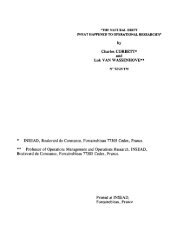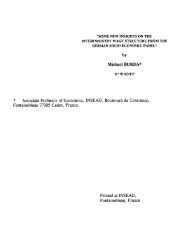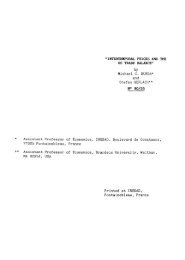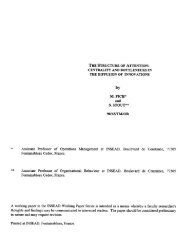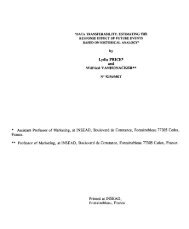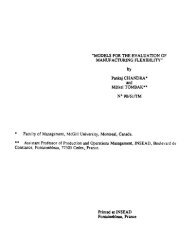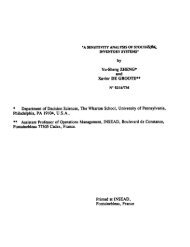* Assistant Professor of Operations Management at INSEAD ...
* Assistant Professor of Operations Management at INSEAD ...
* Assistant Professor of Operations Management at INSEAD ...
Create successful ePaper yourself
Turn your PDF publications into a flip-book with our unique Google optimized e-Paper software.
"INCENTIVE COMPATIBLE EQUILIBRIA IN<br />
MARKETS WITH TIME COMPETITION"<br />
by<br />
C. LOCH•<br />
94/31/TM<br />
* <strong>Assistant</strong> <strong>Pr<strong>of</strong>essor</strong> <strong>of</strong> <strong>Oper<strong>at</strong>ions</strong> <strong>Management</strong> <strong>at</strong> <strong>INSEAD</strong>, Boulevard de Constance,<br />
77305 Fontainebleau Cedex, France.<br />
A working paper in the <strong>INSEAD</strong> Working Paper Series is intended as a means whereby a<br />
faculty researcher's thoughts and findings may be communic<strong>at</strong>ed to interested readers. The<br />
paper should be considered preliminary in n<strong>at</strong>ure and may require revision.<br />
Printed <strong>at</strong> <strong>INSEAD</strong>, Fontainebleau, France
Incentive Comp<strong>at</strong>ible Equilibria in<br />
Markets With Time Competition<br />
Christoph Loch *<br />
<strong>INSEAD</strong><br />
April 1994<br />
Abstract<br />
This paper develops a model with two firms, represented as M/M/1<br />
queues, th<strong>at</strong> compete in a market with N segments <strong>of</strong> imp<strong>at</strong>ient customers,<br />
each segment with different waiting cost r<strong>at</strong>es and price sensitivities.<br />
If both firms have the same processing capabilities, then<br />
the equilibrium will be symmetric on the firm side, i.e., both firms<br />
will have the same outputs and prices per customer segment and not<br />
choose different market niches.<br />
If the firms cannot identify which segment a. customer belongs to<br />
when he/she joins, then the equilibrium generally breaks down, because<br />
customers will have an incentive to che<strong>at</strong> and sign up under a<br />
wrong "type" in order to get preferential tre<strong>at</strong>ment and lower their<br />
total cost. The paper constructs an incentive-comp<strong>at</strong>ible contract<br />
th<strong>at</strong> the firms can <strong>of</strong>fer to the customers in order to re-establish the<br />
equilibrium. This is a generaliz<strong>at</strong>ion <strong>of</strong> the incentive-comp<strong>at</strong>ible pricing<br />
scheme for an internal service facility proposed by Mendelson and<br />
Whang (1990).<br />
*1 would like to thank Haim Mendelson, Michael T. Pich, Seungjin Whang, and especially<br />
J. Michael Harrison for many helpful comments.
1 Introduction<br />
A growing liter<strong>at</strong>ure on time competition examines the n<strong>at</strong>ure <strong>of</strong> oligopolistic<br />
equilibria in markets with imp<strong>at</strong>ient customers. Imp<strong>at</strong>ience causes endogenous<br />
externalities between customers, as the placing <strong>of</strong> an order by one customer<br />
not only imposes waiting on the other customers, but the amount <strong>of</strong><br />
waiting depends on the total volume and thus on the collective actions <strong>of</strong> all<br />
customers. These endogenous externalities represent an altern<strong>at</strong>ive model <strong>of</strong><br />
firm differenti<strong>at</strong>ion from loc<strong>at</strong>ion models, in which the customer externalities<br />
are exogenous, th<strong>at</strong> is, they are constant and given. The convex character<br />
<strong>of</strong> endogenous waiting externalities guarantees the existence <strong>of</strong> pure str<strong>at</strong>egy<br />
oligopolistic equilibria, where in loc<strong>at</strong>ion models in general only mixed<br />
str<strong>at</strong>egy equilibria (with randomiz<strong>at</strong>ion <strong>of</strong> str<strong>at</strong>egies) exist.<br />
In managerial language, one can describe the difference between loc<strong>at</strong>ion<br />
models and models with endogenous externalities as follows. Loc<strong>at</strong>ion<br />
models describe how str<strong>at</strong>egic marketing and engineering decisions (such as<br />
product design, quality, capacity, or facility loc<strong>at</strong>ion) determine differenti<strong>at</strong>ion<br />
and thus shape competition. In the day-to-day oper<strong>at</strong>ing world, these<br />
str<strong>at</strong>egic decisions are fixed. In contrast, endogenous externalities arise when<br />
short term oper<strong>at</strong>ing decisions (such as pricing, production volume decisions<br />
and service discipline) interact with customers' actions and with higher-level<br />
str<strong>at</strong>egic decisions, thus affecting firm differenti<strong>at</strong>ion in the short term. For<br />
this oper<strong>at</strong>ional view, an explicit model <strong>of</strong> firm oper<strong>at</strong>ing capabilities is necessary,<br />
provided in the model <strong>of</strong> this paper by .1111M /1 queues. The oper<strong>at</strong>ional<br />
view <strong>of</strong> firm decisions is usually missing in the economics liter<strong>at</strong>ure on time<br />
competition.<br />
The first contributors to wh<strong>at</strong> is today the time competition liter<strong>at</strong>ure are<br />
De Vany and Saving (1983), who analyze a situ<strong>at</strong>ion where identical firms<br />
serve homogeneous customers who search dynamically among the firms until<br />
they find one with an acceptable full price (The full price is defined as the<br />
sum <strong>of</strong> the monetary price to be paid and the expected waiting cost given<br />
the queue length).<br />
Many extensions <strong>of</strong> the liter<strong>at</strong>ure were developed subsequently, for example,<br />
Lee and Cohen (1985 a and b), Kalai, Kamien and Rubinovitch (1992),<br />
Li and Lee (1991), and Stenbacka and Tombak (1993). Loch (1994) uses a<br />
customer subscription setting to compare the firm behavior under price and<br />
quantity competition and to link the equilibrium characteristics to the capabilities<br />
<strong>of</strong> the firms. All these models have the above mentioned guarantee <strong>of</strong><br />
pure str<strong>at</strong>egy oligopoly equilibria in common.<br />
2
The present paper generalizes the results <strong>of</strong> the time competition liter<strong>at</strong>ure<br />
in two ways. First, it considers several customer groups with differing<br />
levels <strong>of</strong> imp<strong>at</strong>ience, i.e., it breaks the symmetry <strong>of</strong> the model on the market<br />
side. The result is th<strong>at</strong> the equilibrium is still symmetric on the firm side,<br />
th<strong>at</strong> is, each customer group will be tre<strong>at</strong>ed the same by each firm, or in<br />
other words, firms will not differenti<strong>at</strong>e themselves by focusing on different<br />
market niches. Davidson (1988) is the only one who has addressed this question,<br />
and he finds an equilibrium with firm differenti<strong>at</strong>ion. However, this<br />
result only holds for the case where one customer group has zero imp<strong>at</strong>ience,<br />
in which case one firm will target this group with the lowest price and long<br />
waiting times. The result <strong>of</strong> the present paper is th<strong>at</strong>, as long as all customer<br />
groups have some imp<strong>at</strong>ience, firms with equal capabilities will not choose<br />
such targeting <strong>of</strong> a niche in equilibrium.<br />
Second, this paper introduces incentive issues into the analysis <strong>of</strong> oligopoly<br />
equilibria. These issues were first discussed in a well-known paper by Mendelson<br />
and Whang (1990), in the different setting <strong>of</strong> a service facility within a<br />
firm. The facility - one may think <strong>of</strong> a computing center - serves internal<br />
users with differing service requirements as well as different waiting cost<br />
r<strong>at</strong>es. If individual users' imp<strong>at</strong>ience is only known to themselves upon joining<br />
the system, then incentive comp<strong>at</strong>ibility problems arise: users will feel the<br />
tempt<strong>at</strong>ion to "che<strong>at</strong>" (lie about the degree <strong>of</strong> their imp<strong>at</strong>ience) and "buy<br />
the wrong priority class" in order to reduce their full costs (price plus waiting)<br />
<strong>of</strong> the service. This is the well-known phenomenon th<strong>at</strong> the answer to<br />
the question "How fast do you need a response?" is always "immedi<strong>at</strong>ely."<br />
Mendelson and Whang design a pricing scheme th<strong>at</strong> leads to the overall optimum<br />
and gives each user the incentive to buy the "right" class <strong>of</strong> priority<br />
service (i. e., reveal his/her true waiting cost). In order to implement this<br />
scheme, the firm only needs to know the average service time for each priority<br />
class <strong>of</strong> users. The price then depends quadr<strong>at</strong>ically on the actual service<br />
time <strong>of</strong> each individual user.<br />
The Mendelson and Whang pricing scheme corresponds to welfare maximiz<strong>at</strong>ion<br />
<strong>of</strong> an overall planner. The present paper draws on their analysis<br />
and generalizes the incentive-comp<strong>at</strong>ible contract to an oligopolistic market<br />
equilibrium, where customers' true waiting costs are not known to the firms.<br />
In this case, there is no market equilibrium if the firms continue to charge<br />
the simple linear price as before.<br />
The paper is organized as follows: Section 2 describes our basic industry<br />
model. Section 3 looks <strong>at</strong> the oligopolistic equilibrium when customers' iden-<br />
3
tities are known to the firms, establishing th<strong>at</strong> a unique symmetric equilibrium<br />
(on the firm side) exists. Section 4 constructs the generalized incentivecomp<strong>at</strong>ible<br />
pricing scheme th<strong>at</strong> upholds the equilibrium when customers'<br />
identities are not observable. Section 5 gives a summary and outlines further<br />
research.<br />
2 The Model<br />
The model is based on Loch (1994) with the extension to several customer<br />
groups with differing levels <strong>of</strong> imp<strong>at</strong>ience. Consider two firms who compete<br />
for the business <strong>of</strong> many independent <strong>at</strong>omistic customers. The restriction<br />
to two firms is for expositional purposes only and can easily be relaxed. I<br />
will briefly present the model formally and then motiv<strong>at</strong>e the underlying<br />
assumptions. The model (two firms and two customer groups) is illustr<strong>at</strong>ed<br />
in Figure 1.<br />
The firms, indexed by i = 1,2, are identical MI11111 queues. They make<br />
the same products and have the same delivery capabilities; service times <strong>of</strong><br />
different orders are independent, and service times <strong>of</strong> all orders from market<br />
segment n are exponentially distributed with mean vn , regardless <strong>at</strong> which<br />
firm the customer is served. Production costs are normalized to zero, which<br />
is assumed for convenience (it is critical th<strong>at</strong> production costs are the same<br />
for both firms).<br />
The customer popul<strong>at</strong>ion is divided into N groups (or market segments).<br />
A customer in group n (n = 1, , N) is characterized by a waiting cost r<strong>at</strong>e<br />
<strong>of</strong> cn. Thus, imp<strong>at</strong>ience is modeled by linear waiting costs th<strong>at</strong> are born<br />
by the customer. Each <strong>of</strong> the customers may strike a single contract with<br />
a potential vendor, based on the full price (sum <strong>of</strong> cah price plus expected<br />
waiting cost). Once a customer has signed an agreement with a vendor, the<br />
customer will place orders <strong>at</strong> random points in time, forming a Poisson stream<br />
normalized to unit r<strong>at</strong>e A = 1. Thus, the order arrival streams from the<br />
different market segments are independent Poisson streams. A n a Al„ A2„<br />
is the total industry output for type n customers.<br />
Demand from group n is described by the inverse demand curve P„(A„),<br />
which rel<strong>at</strong>es the full price for an order from segment n (nominal price plus<br />
average waiting cost) to the total arrival r<strong>at</strong>e <strong>of</strong> orders from segment n.P„(•)<br />
is taken as primitive here and is assumed to be decreasing. P„(A,,) indic<strong>at</strong>es<br />
wh<strong>at</strong> full price segment n is willing to toler<strong>at</strong>e <strong>at</strong> a segment volume A n. The<br />
inverse demand function could be constructed from more primitive informa-<br />
4
Demand Curve A (P)<br />
Service Requirement g<br />
Delay Cost c 1<br />
Atomistic Imp<strong>at</strong>ient Customers<br />
X 11 '21 12<br />
Random<br />
Order<br />
Streams<br />
Demand Curve 2(P)<br />
Service Requirement 1.1. 2<br />
Delay Cost c 2<br />
Capacity g Capacity g<br />
P = Price + Expected Delay Cost<br />
Figure 1: Two Firms Competing for Two Imp<strong>at</strong>ient Customer Segments<br />
5
tion, for example a distribution <strong>of</strong> customers over the value they derive from<br />
an order (see, e.g., Mendelson and Whang (1990)). The assumption th<strong>at</strong> P.<br />
is decreasing is n<strong>at</strong>ural and expresses the fact th<strong>at</strong> the higher the price, the<br />
lower the total demand.<br />
For the market to be in equilibrium, the full prices <strong>at</strong> all firms must be<br />
the same, because otherwise customers would switch between firms:<br />
Pn(An) =- Pin + CWn(Ail • • • 7 AiN; f); 2 = 1, 2, (1)<br />
where f specifies a scheduling policy employed by the firm and is explained<br />
below. Wn denotes the expected throughput time <strong>of</strong> a type n customer <strong>at</strong><br />
firm i, reflecting the different scheduling tre<strong>at</strong>ment customers <strong>of</strong> different<br />
types experience, and the fact th<strong>at</strong> the function Wn is the same for both<br />
firms.<br />
Without loss <strong>of</strong> generality, the groups can be ordered such th<strong>at</strong> the waiting<br />
cost to service time r<strong>at</strong>io decreases with the group number: c.A. ><br />
= 1, , (N — 1). This ordering anticip<strong>at</strong>es the st<strong>at</strong>ic priority<br />
scheme th<strong>at</strong> we show below to be optimal (and which is commonly referred<br />
to as the "c-p rule").<br />
The subscription process works as follows. Each firm i must simultaneously<br />
post N quantities Ail , , AiN , one for each customer group. Prices are<br />
then determined by the market within each group, depending on the total<br />
industry output for the group and the expected delays. Th<strong>at</strong> is, firms engage<br />
in a game <strong>of</strong> quantity competition, for which the next section will characterize<br />
the form <strong>of</strong> the unique Nash equilibrium. Price competition is expected<br />
to make firm behavior more aggressive (increase output and decrease prices)<br />
and is not discussed here.<br />
The decision problem for each firm includes N quantities as decision variables<br />
and N inverse demand rel<strong>at</strong>ionships, taking as given autom<strong>at</strong>ic price adjustment<br />
achieving the market equilibrium. Each firm must now also choose<br />
a scheduling policy. A scheduling policy specifies <strong>at</strong> each point in time when<br />
an arrival occurs or a service is completed (these points in time are called<br />
decision points), which job present <strong>at</strong> the facility will be served next, or<br />
whether the facility will be idle until the next arrival or service completion.<br />
Each firm must announce its st<strong>at</strong>ionary scheduling policy f <strong>at</strong> the beginning<br />
<strong>of</strong> the period, and then customers can assess wh<strong>at</strong> average waiting times<br />
result from th<strong>at</strong> scheduling policy.<br />
FIFO is an example <strong>of</strong> a simple scheduling policy. It always applies the<br />
rule: "serve the customer next who has been waiting the longest", regardless<br />
6
<strong>of</strong> system st<strong>at</strong>us (e.g., number <strong>of</strong> customers <strong>of</strong> each type present). More<br />
general policies are dynamic, or system-st<strong>at</strong>us dependent. Th<strong>at</strong> means th<strong>at</strong><br />
the decision <strong>of</strong> who to serve next depends on the customer mix present in<br />
the queue, e.g., on the number <strong>of</strong> customers <strong>of</strong> each type currently waiting.<br />
An important special policy is the st<strong>at</strong>ic priority ranking policy (preemptive<br />
or non-preemptive), which always grants service next to the customer in the<br />
queue who is <strong>of</strong> the type with the lowest index (the highest product cp),<br />
regardless <strong>of</strong> the st<strong>at</strong>e <strong>of</strong> the system. This policy is important because it has<br />
been shown to minimize total waiting cost in the system if the arrival r<strong>at</strong>es<br />
An are given.<br />
Throughout the paper, I consider only Nash equilibria in pure str<strong>at</strong>egiesl.<br />
To avoid degeneracies, I assume th<strong>at</strong> p i > 1/P„(0) for all i. Any firm th<strong>at</strong><br />
does not meet this condition has so little capacity (performs service so slowly)<br />
th<strong>at</strong> even without any congestion, orders take so long th<strong>at</strong> no customers are<br />
interested. In th<strong>at</strong> case, this firm will not produce anything in equilibrium.<br />
As is evident in the description <strong>of</strong> the model, customers subscribe to a<br />
firm's services r<strong>at</strong>her than go out and search for the best deal whenever<br />
the need for an order arises, i. e., they place orders st<strong>at</strong>ically r<strong>at</strong>her than<br />
dynamically. This simplifies analysis and reflects the fact th<strong>at</strong> suppliers <strong>of</strong>ten<br />
have longterm rel<strong>at</strong>ionships with their customers. Furthermore, the linear<br />
waiting cost structure makes the qualit<strong>at</strong>ive results in models with dynamic<br />
customer decisions similar (see, e.g., Li and Lee (1991)).<br />
In order to interpret the product <strong>of</strong> waiting cost and average service r<strong>at</strong>e,<br />
the reader may look <strong>at</strong> two extreme cases. First, consider the situ<strong>at</strong>ion when<br />
all customer groups have the same service times, or p n = p for all n. In this<br />
case, group 1 is the most imp<strong>at</strong>ient group, and increasing n means decreasing<br />
imp<strong>at</strong>ience. The second extreme case occurs when all waiting cost r<strong>at</strong>es are<br />
the same, cn = c for all n. In this case, group 1 is the fastest processed group,<br />
and increasing n means decreasing speed <strong>of</strong> service. The group identific<strong>at</strong>ion<br />
criterion is thus a combin<strong>at</strong>ion <strong>of</strong> imp<strong>at</strong>ience and service speed; both high<br />
imp<strong>at</strong>ience or high service speed can result in a high ranking (low index) <strong>of</strong><br />
a group.<br />
With the customer groups, the model introduces an asymmetry in the<br />
market (as opposed to an asymmetry between the firms), and the next section<br />
will examine whether this asymmetry allows the existence <strong>of</strong> asymmetric<br />
equilibria in this industry.<br />
'Pure str<strong>at</strong>egies exclude a firm from having several altern<strong>at</strong>ive str<strong>at</strong>egies, among which<br />
it randomly picks one.<br />
7
3 Equilibrium With Identifiable Customers'<br />
Types<br />
In this Section, it is assumed th<strong>at</strong> each firm can identify the type <strong>of</strong> a customer<br />
when she is placing an order. This assumption will be relaxed in the<br />
next subsection. Firm i must thus announce quantities ail , ... , AiN together<br />
with a st<strong>at</strong>ionary scheduling policy f.<br />
Following Harrison (1975), a st<strong>at</strong>ionary policy is defined as follows: The<br />
st<strong>at</strong>e <strong>of</strong> the system is s = (n1,...,nN), where ni is a nonneg<strong>at</strong>ive integer<br />
and corresponds to the number <strong>of</strong> jobs <strong>of</strong> the respective type present in the<br />
system. Note th<strong>at</strong> this st<strong>at</strong>e description does not contain any inform<strong>at</strong>ion<br />
about the waiting time already spent by jobs present in the queue. This<br />
is sufficient because we have assumed a linear waiting cost structure: Only<br />
the average wait <strong>of</strong> jobs <strong>of</strong> a given type m<strong>at</strong>ters, not the experience <strong>of</strong> an<br />
individual job. In other words, one can associ<strong>at</strong>e a. certain total waiting cost<br />
r<strong>at</strong>e with any given st<strong>at</strong>e <strong>of</strong> the system, regardless <strong>of</strong> how long the individual<br />
jobs in the queue have already been waiting. The available action set is<br />
A(s) = {0} U {i : ni > 0), where action 0 corresponds to choosing idleness,<br />
and action i corresponds to serving type i (whenever th<strong>at</strong> type is present<br />
in the system). Once a service is begun, it must be completed without<br />
interruption, and if idleness is chosen, a service cannot be started until the<br />
next arrival.<br />
A deterministic decision rule is a function f th<strong>at</strong> associ<strong>at</strong>es with each<br />
st<strong>at</strong>e s a corresponding action f(s) E A(s), and the corresponding st<strong>at</strong>ionary<br />
policy follows decision rule f <strong>at</strong> each decision point. Decision points are times<br />
<strong>of</strong> arrival or departure <strong>of</strong> an order.<br />
With the scheduling rule f, firm i solves the following decision problem:<br />
Max over A il ,— , AiN; f : IT; a Eno] AinAn<br />
subject to: Vn = 1, ... , N :<br />
Pn(Ain + A2n) = An -1- CniVn ( Ail , • • - , AiN; f);<br />
Ain > 0,<br />
where price feasibility is ensured by the requirement th<strong>at</strong> pi > 1/Pn(0) for<br />
all n.<br />
The following proposition shows th<strong>at</strong> both firms will prefer st<strong>at</strong>ic priorities<br />
to any dynamic scheduling policy, and it characterizes the n<strong>at</strong>ure <strong>of</strong> the<br />
equilibrium in this industry.<br />
8
Proposition 1 Assume th<strong>at</strong> two firms described by 111/1II/1 queues engage in<br />
quantity competition, and th<strong>at</strong> the customer popul<strong>at</strong>ion consists <strong>of</strong> N groups,<br />
indexed by n = N, with delay cost to average service time r<strong>at</strong>ios c„1.1„<br />
decreasing in n. Assume th<strong>at</strong> Vn, Pn(•) are concave decreasing and th<strong>at</strong> each<br />
firm can <strong>of</strong>fer any st<strong>at</strong>ionary scheduling policy.<br />
Then it is optimal for both firms to adopt a st<strong>at</strong>ic priority policy, where<br />
type n customers are assigned higher priority than type (n 1) customers.<br />
If the firms have sufficient capacity, i.e., /I n > P Vn, then there exists<br />
a unique equilibrium th<strong>at</strong> is symmetric, i.e., for all n: Ain = A2n a An. The<br />
firm outputs are characterized by the rel<strong>at</strong>ionships<br />
N<br />
Vn = 1, N : Pn(An) — — E<br />
J.1<br />
ow,<br />
_O.<br />
aAn<br />
(2)<br />
Pro<strong>of</strong>.<br />
The pro<strong>of</strong> is included in the appendix. The reader will notice th<strong>at</strong> the pro<strong>of</strong><br />
holds for the more general case <strong>of</strong> the firms being MIGIl queues; the formul<strong>at</strong>ion<br />
<strong>of</strong> the proposition is restricted to the 1111.111.11 case only to be consistent<br />
with the assumptions <strong>of</strong> Proposition 2.<br />
Proposition 1 st<strong>at</strong>es th<strong>at</strong> as long as the capabilities <strong>of</strong> the firms are the<br />
same, not even asymmetries in the imp<strong>at</strong>ience <strong>of</strong> the customer popul<strong>at</strong>ion<br />
make asymmetric equilibria on the firm side possible. Firms will not differenti<strong>at</strong>e<br />
into different niches, but all approach the market in the same manner.<br />
If the firms' capabilities (the service r<strong>at</strong>es) differ, then have consistently<br />
found in numerical examples th<strong>at</strong> a firm th<strong>at</strong> is superior in all segments will<br />
also capture a higher share and charge a higher price in all segments. Only<br />
if a firm has a unique capability in one segment (modeled by a specific pin),<br />
one will observe a specific niche str<strong>at</strong>egy exhibited by one firm. Although<br />
we have not proven these results in general, the findings suggest th<strong>at</strong> time<br />
differenti<strong>at</strong>ion has to be backed up by firm capabilities even in the case <strong>of</strong><br />
customer groups with differing imp<strong>at</strong>ience (see Loch (1994) for a discussion<br />
<strong>of</strong> the homogeneous customer case).<br />
Wh<strong>at</strong> are the welfare implic<strong>at</strong>ions <strong>of</strong> the equilibrium described? Consider<br />
a social planner who wants to maximize the total welfare in an industry<br />
with N customer groups and two non-pooled production facilities. Observe<br />
th<strong>at</strong> customer group n receives utility fzAfo Pn (x)dx from an order stream <strong>of</strong><br />
9
volume An. From the convexity <strong>of</strong> the waiting costs it follows directly th<strong>at</strong><br />
the same volume must be assigned to each one <strong>of</strong> the two facilities. Now the<br />
social planner's maximiz<strong>at</strong>ion problem can be written as<br />
Max: EN.-1 fro Pn (x)dx — EnN_I c„A„ (Ai , , AN)<br />
subject to: 0 < An, n = 1, N; i Enisi—i A n < 11-<br />
The FOC for this problem ar<br />
N<br />
ow,<br />
n (An) — c„147,, — c •— =<br />
aAn<br />
Comparison <strong>of</strong> equ<strong>at</strong>ions (3) with equ<strong>at</strong>ions (2) shows th<strong>at</strong> welfare optimiz<strong>at</strong>ion<br />
requires strictly gre<strong>at</strong>er consumption <strong>of</strong> both customer groups than the<br />
duopoly equilibrium provides. Oligopoly is inefficient for all customer groups,<br />
with firms underproducing in order to capture higher prices. This is consisteht<br />
with and a generaliz<strong>at</strong>ion <strong>of</strong> previous results.<br />
4 Equilibrium With Non-Identifiable Customers'<br />
Types<br />
I now return to the assumption th<strong>at</strong> the firms can identify customer types<br />
upon placement <strong>of</strong> orders. This ability allows the firms to implement the<br />
optimal priority scheme regardless <strong>of</strong> possible customer desire to get the<br />
tre<strong>at</strong>ment reserved for another customer type. If the firms cannot observe<br />
a customer's type, then customers can lie about their type. For example, a<br />
type n customer can claim to be <strong>of</strong> type m, pay the type m price and receive<br />
lower priority service if it seems advantageous to her. A customer has the<br />
incentive to tell the truth if th<strong>at</strong> makes her expected cost <strong>of</strong> obtaining the<br />
service lower than if she lies about her type. This is expressed in the following<br />
incentive comp<strong>at</strong>ibility condition:<br />
j=1<br />
Vn m : pn, + < pm + IV, (4)<br />
The incentive comp<strong>at</strong>ibility condition says th<strong>at</strong>, from the viewpoint <strong>of</strong> a<br />
type n customer, the price charged to a. different type m. must be higher than<br />
the own price plus the difference in waiting cost (evalu<strong>at</strong>ed <strong>at</strong> type n's cost<br />
r<strong>at</strong>e). If the price for the other group is too low, the type n customer finds<br />
it advantageous to lie about her type and subscribe to type m service.<br />
10<br />
oVn = 1,— ,N : P<br />
(3)
This condition will usually not be fulfilled. If it is not fulfilled, then there<br />
is no customer differenti<strong>at</strong>ing equilibrium, because the firms have no way<br />
to distinguish the customers other than direct type identific<strong>at</strong>ion. Such a<br />
situ<strong>at</strong>ion is demonstr<strong>at</strong>ed in the following example.<br />
The market consists <strong>of</strong> 2 segments, with a high priority segment A and a<br />
low priority segment B. The groups are characterized by cA = 2 and pA = 5,<br />
whereas cB = 3 and fiB = 3. Thus cApA = 10 > 9 = cE4.43. Th<strong>at</strong> is, group A<br />
has the higher imp<strong>at</strong>ience-to-service time r<strong>at</strong>io, even though group B has a<br />
higher waiting cost r<strong>at</strong>e and is thus more imp<strong>at</strong>ient in the usual sense <strong>of</strong> the<br />
word. 2 The demand functions are PA(AA) = 1—A A and PB(AB) = 10-10AB.<br />
Thus, both groups are <strong>of</strong> the same size, but group B is more price sensitive<br />
and toler<strong>at</strong>es a higher maximum full price <strong>of</strong> 10.<br />
We insert these numbers into the formulae for the average delay and into<br />
the FOC, equ<strong>at</strong>ions (2), and we solve the FOC numerically. We find th<strong>at</strong><br />
in equilibrium each firm produces volumes <strong>of</strong> AA = 0.149 and AB = 0.292.<br />
These volumes result in prices <strong>of</strong> pA = 0.222 and pB = 3.015 and in delays<br />
<strong>of</strong> WA = 0.239 and WB = 0.379. The incentive comp<strong>at</strong>ibility condition<br />
requires th<strong>at</strong> pA > pB . However, type B customers end up paying more for<br />
inferior service! If the firms cannot identify customers upon placement <strong>of</strong> an<br />
order, type B customers see the chance <strong>of</strong> switching to lower price and faster<br />
delivery by lying about their type and subscribing as type A customers. The<br />
equilibrium breaks down. The market is unable to produce prices th<strong>at</strong> clear<br />
the quantities <strong>of</strong>fered by the two firms (who engage in quantity competition).<br />
Before I propose a contract th<strong>at</strong> restores the equilibrium, some remarks<br />
should illumin<strong>at</strong>e the circumstances under which it can occur th<strong>at</strong> the linear<br />
prices emerging from a full-inform<strong>at</strong>ion equilibrium are not incentive comp<strong>at</strong>ible.<br />
Inspection <strong>of</strong> the incentive-comp<strong>at</strong>ibility condition (4) reveals two<br />
types <strong>of</strong> situ<strong>at</strong>ions leading to incentive problems:<br />
1. The r<strong>at</strong>io c„ p„ is very high in comparison to some other type's cmitm<br />
because p 7, pm. In this case, the delivery time for m customers is<br />
very large by the sheer size <strong>of</strong> the raw service time, and this is not<br />
compens<strong>at</strong>ed for by a small waiting cost. Even though the cash price<br />
pm is not too large, the full price Pm is mainly driven by the waiting<br />
cost component and produces an incentive for type m customers to lie.<br />
2 Recall th<strong>at</strong> both firms have the same capacities, so the service r<strong>at</strong>es named above hold<br />
<strong>at</strong> both firms.<br />
11
2. Type 7n customers are price-insensitive compared to type n customers:<br />
The firms, trying to maximize their own pr<strong>of</strong>its, set quantities such<br />
as to extract prices as high as the demand curves <strong>of</strong> the customer<br />
groups permit, without consider<strong>at</strong>ions <strong>of</strong> how the prices for the groups<br />
compare. It can thus happen th<strong>at</strong> the price for type n service is too<br />
high in equilibrium, cre<strong>at</strong>ing the incentive for n customers to lie and<br />
to subscribe as type m customers.<br />
The question is: Can the firms <strong>of</strong>fer subscription contracts to the customers<br />
which restore the equilibrium? In other words, are there contracts which<br />
produce the right expected full price for the customers (and thus bring about<br />
the right industry output) and induce the customers to either lie or reveal<br />
their true type in a predictable fashion? 3 In the remainder <strong>of</strong> this subsection,<br />
we will construct such contracts.<br />
First, we can actually restrict <strong>at</strong>tention to a. much narrower class <strong>of</strong> contracts,<br />
namely, those in which customers reveal their true types and do not<br />
lie <strong>at</strong> all. This follows from the famous revel<strong>at</strong>ion principle (Myerson 1979),<br />
which st<strong>at</strong>es th<strong>at</strong> without loss <strong>of</strong> generality, the firms may restrict themselves<br />
to contracts which require the customers to subscribe under their true types<br />
and give them no incentive to lie.<br />
One piece <strong>of</strong> not<strong>at</strong>ion is necessary in order to describe the proposed contract.<br />
Let rn., denote the actual service time <strong>of</strong> an arbitrary job placed by a<br />
type m customer. Then the description <strong>of</strong> our model specifies th<strong>at</strong> T m is an<br />
exponentially distributed random variable with mean -i, .<br />
Now suppose th<strong>at</strong> firm i, after having committed to outputs A il, , AiN,<br />
<strong>of</strong>fers the following contract: For each order placed by a customer <strong>of</strong> unknown<br />
type rn under a subscription <strong>of</strong> type n, a price will be paid <strong>of</strong> the amount<br />
qn E pn + h(Tm ) + g(rn, 2 ), where pn is the market price determined by the<br />
collective bidding process <strong>of</strong> all type n. customers, and where h and g are real<br />
functions. The price for a customer is now a random variable. The specified<br />
contract solves the problem if it has two properties: First, if all customers<br />
sign up for the contracts corresponding to their true types, the expected<br />
price paid must be the full-inform<strong>at</strong>ion linear price. Eqa = pn Vn. Second,<br />
the expected prices must fulfill the incentive comp<strong>at</strong>ibility conditions (4).<br />
A first candid<strong>at</strong>e for such a contract is the pricing scheme found in<br />
Mendelson and Whang (1990). 4 In Theorem 1.1, they derive the optimal<br />
3As long as the customers' behavior is predictable, the firms can produce the desired<br />
market outcome in terms <strong>of</strong> volumes and full prices.<br />
'In the following summary <strong>of</strong> the Mendelson and Whang results, I have adjusted their<br />
1 2
price charged by an internal service facility as<br />
ow<br />
p: = E for n = 1, , N.<br />
j.i 0An<br />
In Theorem 3.2, they propose a contract <strong>of</strong> the form qn (7-„,) = Anrm BrZ<br />
such th<strong>at</strong> E qn(rn) = p: and show th<strong>at</strong> this contract is incentive-comp<strong>at</strong>ible<br />
(all users tell the truth) and thus implements the equilibrium.<br />
From equ<strong>at</strong>ions (2), the equilibrium price dict<strong>at</strong>ed by the market in the<br />
present model, given th<strong>at</strong> the firms put out the equilibrium quantities, is<br />
, ow;<br />
Pn = E ciAjTjTn- AnPni (An) = q i: — AnPn (An) for n = 1, , N. (5)<br />
=1<br />
Observe th<strong>at</strong> the q: in equ<strong>at</strong>ion (5) has the same functional form as the<br />
Mendelson and Whang price The extra term in equ<strong>at</strong>ion (5) can be<br />
interpreted as the decrease in revenue associ<strong>at</strong>ed with price deterior<strong>at</strong>ion<br />
caused by a volume increase <strong>of</strong> one unit. Therefore, the duopoly equilibrium<br />
price is larger than the welfare maximizing price (even though a volume<br />
reduction <strong>of</strong>fsets part <strong>of</strong> the increase caused by the revenue term).<br />
Because <strong>of</strong> the extra revenue term, Mendelson and Whang's incentive<br />
pricing scheme cannot be used directly by the duopolists. However, it is<br />
possible to construct a generaliz<strong>at</strong>ion <strong>of</strong> the Mendelson and Whang scheme<br />
th<strong>at</strong> implements the duopoly equilibrium and is incentive-comp<strong>at</strong>ible. Reestablishing<br />
the equilibrium requires th<strong>at</strong> the firms put out the equilibrium<br />
quantities given by equ<strong>at</strong>ions (2) and then charge a service-time dependent<br />
price qn(rm ), whose expect<strong>at</strong>ion for the customer is the equilibrium price set<br />
by the market.<br />
Proposition 2 Consider the contract<br />
where:<br />
1<br />
qn(rm.) = Anrm + — (B —<br />
2<br />
ran rainke(i...N)1{n}<br />
)rm2 777_ 111„<br />
„ (Tin _1)2 AnP,',(An), (6)<br />
mn tin<br />
11, ).21 0,<br />
Mn c rnax kE{1...N} { –Ak Pik(Ak) AnP, (An)} 10,<br />
and An and B are the constants defined in<br />
Mendelson and Whang.<br />
not<strong>at</strong>ion to m<strong>at</strong>ch the not<strong>at</strong>ion used in the present model.<br />
5 For completeness, the constants are presented in the pro<strong>of</strong>.<br />
13
This contract implements the market equilibrium characterized by equ<strong>at</strong>ions (2)<br />
and is incentive-comp<strong>at</strong>ible.<br />
Pro<strong>of</strong>.<br />
The pro<strong>of</strong> is included in the appendix. As in Proposition 1, the analysis<br />
actually holds for the more general case <strong>of</strong> M/G/1 queues: The reader will<br />
notice th<strong>at</strong> the assumption <strong>of</strong> exponential service times shapes the form <strong>of</strong><br />
the contract via the fact th<strong>at</strong> E[r,„2 ] = -. For other distributions, .E[7,1] =<br />
. Thus, the contract can be constructed in general for MIGI1 queues,<br />
as long as the variances <strong>of</strong> all customer service time distributions are provided<br />
to the firms as additional inform<strong>at</strong>ional inputs.<br />
I will now try to develop some intuition about the rel<strong>at</strong>ionship between the<br />
Mendelson and Whang pricing scheme and the contract proposed here. Recall<br />
the two reasons for incentive-incomp<strong>at</strong>ibility <strong>of</strong> the equilibrium price<br />
listed above. The first reason is the possibility th<strong>at</strong> the service requirement<br />
<strong>of</strong> a customer type is too large, driving the full price up too high. This comp<strong>at</strong>ibility<br />
failure can happen in the Mendelson and Whang pricing problem as<br />
well, and their scheme is designed to elimin<strong>at</strong>e the failure: The constants B<br />
and An, n = 1, , N have the property th<strong>at</strong> they penalize lying sufficiently<br />
to <strong>of</strong>fset incentive incomp<strong>at</strong>ibilities caused by large service requirements.<br />
The second failure is caused by price-insensitivity <strong>of</strong> customer types. The<br />
equilibrium price is as high as the demand rel<strong>at</strong>ionship allows, even if this<br />
cre<strong>at</strong>es the incentive for customers to subscribe under a. different type. This<br />
problem does not occur in the Mendelson/Whang model, and thus their pricing<br />
scheme does not address it. The components in our contract containing<br />
the expression '1' m.112- penalize lying again, this time in order to <strong>of</strong>fset the problems<br />
caused by types being too price-insensitive.<br />
Notice th<strong>at</strong> the contract proposed here reduces to the Mendelson and<br />
Whang scheme (adjusted by a constant), if all customer types have the same<br />
demand rel<strong>at</strong>ionship. Thus, the present contract is a generaliz<strong>at</strong>ion <strong>of</strong> the<br />
Mendelson and Whang scheme.<br />
Notice also th<strong>at</strong> the present contract depends critically on the average<br />
service requirements being different for each customer type. The service<br />
r<strong>at</strong>es are exploited as signals about the identity <strong>of</strong> the customer and her<br />
demand rel<strong>at</strong>ionship. If the service r<strong>at</strong>es <strong>of</strong> several customer types are the<br />
same, then the contract cannot prevent them from lying to exploit differences<br />
in price sensitivities. The case when service r<strong>at</strong>es are the same is the most<br />
14
problem<strong>at</strong>ic in the situ<strong>at</strong>ion described by the present model. Only additional<br />
inform<strong>at</strong>ion about customers will help the firms to restore the equilibrium.<br />
In contrast, the Mendelson and Whang model autom<strong>at</strong>ically enjoys incentive<br />
comp<strong>at</strong>ibility when service r<strong>at</strong>es are equal, because demand rel<strong>at</strong>ionships<br />
and differing price sensitivities are absent. Thus, the most favorable situ<strong>at</strong>ion<br />
in their model becomes the most problem<strong>at</strong>ic case in this model.<br />
I conclude this section with an example th<strong>at</strong> demonstr<strong>at</strong>es the implement<strong>at</strong>ion<br />
<strong>of</strong> the equilibrium via the proposed contract. The example has the<br />
standard two firms and three market segments. The three order types are<br />
characterized by service r<strong>at</strong>es <strong>of</strong> (p i , /1 2 , p3) = (6, 3,5). The waiting cost<br />
r<strong>at</strong>es are (c1 , e2 , c3) = (2,3,1.5). Then the waiting-cost-to-service-time r<strong>at</strong>ios<br />
are (12,9, 7.5) for the three groups, which means th<strong>at</strong> type 1 orders<br />
receive highest and type 3 orders receive lowest service priority. The specific<strong>at</strong>ion<br />
<strong>of</strong> the example is completed by the three demand curves, which are<br />
(Pi (x), P2 (y), P3(z)) = (2 — 2x,10 — 10y, 2 — 2z). We observe th<strong>at</strong> all three<br />
segments are <strong>of</strong> the same size, and the second segment is more price-sensitive<br />
than the other two.<br />
Each firm produces an output <strong>of</strong> (A l , A2, A3 ) = (0.246, 0.285,0.255) in<br />
equilibrium. The corresponding average throughput times are (W1 , W2 , W3) =<br />
(0.217, 0.392,0.269), and the market-determined cash prices are (p i , p2, p3)<br />
(0.583,3.123, 0.577). It may be surprising th<strong>at</strong> type 2's throughput time is<br />
longer than type 3's, although type 2 has higher priority. This is caused by<br />
the type 2 service time * being almost twice as long as *, which more than<br />
makes up for the shorter time spent waiting in the queue.<br />
Figure 2 demonstr<strong>at</strong>es th<strong>at</strong> the equilibrium prices do not fulfill the incentive<br />
comp<strong>at</strong>ibility condition. The first table in the figure shows th<strong>at</strong> both<br />
type 2 and type 3 customers have an incentive to lie and sign up as type 1,<br />
because th<strong>at</strong> will lower their expected full prices.<br />
The second table in Figure 2 presents the d<strong>at</strong>a <strong>of</strong> the contract according<br />
to Proposition 2. The third table specifies the expected full prices for<br />
the different signup-options <strong>of</strong> the customers under the incentive-comp<strong>at</strong>ible<br />
pricing contract. We see th<strong>at</strong> it is in the best interest <strong>of</strong> all customers to sign<br />
up under their true types. The customers truthfully separ<strong>at</strong>e themselves,<br />
and moreover, if they tell the truth, then they face expected full prices equal<br />
to the full prices in the equilibrium in the first table.' Thus the proposed<br />
6The slight differences between the diagonal elements in the first and the third table<br />
are due to rounding errors.<br />
15
Sign up as:<br />
Sign up as:<br />
True Tvoe<br />
1 2 3<br />
1 1.02 1.23 0.91<br />
2 3.91 4.30 3.71<br />
3 1.12 1.39 0.98<br />
Full Prices Without Incentive-Comp<strong>at</strong>ible Contract<br />
B 1.94<br />
Type n A M m<br />
1 0.04 2.36 0.0011<br />
2 0.02 0.00 0.0178<br />
3 0.00 2.34 0.0011<br />
D<strong>at</strong>a <strong>of</strong> the Incentive-Comp<strong>at</strong>ible Contract<br />
True Tvoe<br />
1 2 3<br />
1 0.99 60.35 3.26<br />
2 3.69 4.29 41.27<br />
3 3.44 38.99 0.99<br />
Full Prices With Incentive-Comp<strong>at</strong>ible Contract<br />
Figure 2: Equilibrium With Incentive-Comp<strong>at</strong>ible Contract<br />
contract implements the equilibrium as was claimed.<br />
Observe th<strong>at</strong> A3 in Figure 2 is equal to zero. This expresses the fact th<strong>at</strong><br />
no penaliz<strong>at</strong>ion is necessary to <strong>of</strong>fset a waiting cost reduction obtained by<br />
falsely signing up as type 3, because type 3 has the highest expected waiting<br />
time anyway.<br />
The reader may also also observe th<strong>at</strong> M2 = 0, which is the case because<br />
the type 2 demand function is the most price-sensitive. This drives price p2<br />
up sufficiently, and there is no need to penalize for falsely signing up as type<br />
2.<br />
5 Summary and Conclusion<br />
This paper provides support to the result th<strong>at</strong> "time competition is capability<br />
competition" (Loch 1994), which means th<strong>at</strong> differenti<strong>at</strong>ion in the behavior<br />
16
<strong>of</strong> different firms, modeled as MI11111 queues, can only be explained by<br />
differences in the firms' capabilities. As long as the capabilities are the same,<br />
firms will behave similarly in the market and not differenti<strong>at</strong>e, even if the<br />
customer popul<strong>at</strong>ion has segments <strong>of</strong> differing characteristics (imp<strong>at</strong>ience and<br />
price sensitivity). This result holds, more generally, for MICA queues.<br />
In addition, the analysis in the present paper shows th<strong>at</strong> priv<strong>at</strong>e inform<strong>at</strong>ion<br />
on the side <strong>of</strong> the customers can cause the market equilibrium to break<br />
down. If the firms cannot observe the types (imp<strong>at</strong>ience and service requirement<br />
characteristics) <strong>of</strong> customers upon placing orders, customers may have<br />
the incentive to lie about their imp<strong>at</strong>ience in order to lower their total cost<br />
<strong>of</strong> service. This prevents the market from clearing. It is, however, possible<br />
for the firms to modify the contracts <strong>of</strong>fered to the customers to re-establish<br />
a functioning market, analogous to the case <strong>of</strong> an internal service facility<br />
with multiple customer types, which is presented by Mendelson and Whang<br />
(1990).<br />
For the case where the firms engage in quantity competition, the paper<br />
has constructed a contract in which the price per order depends on the actual<br />
service time in such a way th<strong>at</strong> the expected price is the market-established<br />
price and all customers reveal their true type. It is shown th<strong>at</strong> such a contract<br />
can always be found and is comp<strong>at</strong>ible both with the firms' equilibrium<br />
conditions and true revel<strong>at</strong>ion <strong>of</strong> type by the customers. More generally,<br />
firms modeled as M/G/1 queues can also construct an incentive comp<strong>at</strong>ible<br />
contract, if the second moments <strong>of</strong> all service time distributions are known<br />
to them.<br />
It is desirable to establish an analogous result for the case <strong>of</strong> price•competition,<br />
because price competition is more intuitive in some situ<strong>at</strong>ions, and<br />
because the two types <strong>of</strong> competition should be compared.<br />
Another area to be explored is the situ<strong>at</strong>ion when the proposed incentive<br />
comp<strong>at</strong>ible contract cannot be implemented, for example when regul<strong>at</strong>ion<br />
forbids identific<strong>at</strong>ion and differential tre<strong>at</strong>ment <strong>of</strong> customers. In this case,<br />
it is not clear whether firms will settle in an inefficient equilibrium with all<br />
customers being tre<strong>at</strong>ed the same, or whether now differenti<strong>at</strong>ion becomes a<br />
possible equilibrium, with firms dividing the market along segment lines.<br />
17
A Pro<strong>of</strong>s <strong>of</strong> Propositions<br />
A.1 Pro<strong>of</strong> <strong>of</strong> Proposition 1<br />
I first show th<strong>at</strong> st<strong>at</strong>ic priority policies are optimal. Say firm 1 can choose<br />
from a menu <strong>of</strong> policies F E {fr, Suppose the firm chooses a<br />
policy ff. Customers can evalu<strong>at</strong>e their expected waiting costs via the<br />
functions W„ ( • • •). Then prices are determined by the type n (n = 1, , N)<br />
demand rel<strong>at</strong>ionships for customers th<strong>at</strong> subscribe to firm 1 under policy<br />
fy°. Suppose now th<strong>at</strong> the firm is allowed to re-negoti<strong>at</strong>e the contracts if the<br />
customers agree. We know from Kakalik (1969) th<strong>at</strong> with given arrival r<strong>at</strong>es<br />
the total waiting costs are minimized if st<strong>at</strong>ic priorities are chosen, where<br />
the rel<strong>at</strong>ively more imp<strong>at</strong>ient customers receive higher priority. Therefore,<br />
by switching to the st<strong>at</strong>ic priority scheme, the firm can reduce or <strong>at</strong> least<br />
maintain waiting costs, and thus increase or <strong>at</strong> least maintain prices and<br />
pr<strong>of</strong>its while leaving customers equally well <strong>of</strong>f. This argument holds for any<br />
policy ff . Therefore, there exists <strong>at</strong> least one optimal st<strong>at</strong>ic priority policy<br />
for the firm to <strong>of</strong>fer in the first place.<br />
I now show existence and uniqueness <strong>of</strong> the equilibrium. The pay<strong>of</strong>f function<br />
<strong>of</strong> firm 1 is given by<br />
U3. on, • • • , AIN) = E Pn(nn) — cn iVn(Aii , AiN)•<br />
n=1<br />
We know th<strong>at</strong> Pn is positive and concave decreasing and th<strong>at</strong> the IY„ . are<br />
positive and strictly convex increasing in all arguments (and this remains<br />
true for the M/G/1 queue)'. Therefore, U1 is strictly concave in all its<br />
arguments, which implies pseudoconcavity.<br />
The action set <strong>of</strong> firm 1 is described by:<br />
X1 = {(x1,...,sN) > 0 : Pn(x„ A 2„) — , x n ) > 0}.<br />
This set is a nonempty, closed and continuous correspondence <strong>of</strong> the actions<br />
<strong>of</strong> firm 2. It is also a convex set: Pn — cn IVT, is a concave function in all<br />
arguments, so if it is nonneg<strong>at</strong>ive for two points (x l, xN ) and (yi, , yN)<br />
in firm l's action space, it is also nonneg<strong>at</strong>ive for any convex combin<strong>at</strong>ion <strong>of</strong><br />
7This can easily be derived from the Pollaczek-Khintchine formulas for the average<br />
waiting times <strong>of</strong> high and low priority customers, see, for example, Gross and Harris<br />
(1985), page 282 1.<br />
18
the two points. By symmetry, everything we have said about firm 1 is true<br />
for firm 2 as well.<br />
We have thus verified the conditions for the generalized existence theorem<br />
(Proposition 7.4. Harker and Pang 1990) and can conclude th<strong>at</strong> an<br />
equilibrium to the game with two customer groups exists.<br />
Furthermore, Proposition 7.3. in Harker and Pang (1990) describes the<br />
equivalent vari<strong>at</strong>ional inequality problem associ<strong>at</strong>ed with our equilibrium<br />
problem. Strict concavity <strong>of</strong> U E (U1 , . , U N)T guarantees th<strong>at</strong> the function<br />
F in the vari<strong>at</strong>ional inequality is strictly monotone. Thus, Proposition 3.2.<br />
in Harker and Pang (1990) tells us th<strong>at</strong> there is <strong>at</strong> most one solution to the<br />
vari<strong>at</strong>ional inequality (and therefore <strong>at</strong> most one equilibrium). We have now<br />
established existence <strong>of</strong> a unique equilibrium, which must be symmetric by<br />
the symmetry <strong>of</strong> the firms. o<br />
A.2 Pro<strong>of</strong> <strong>of</strong> Proposition 2<br />
First, I show th<strong>at</strong> the full inform<strong>at</strong>ion equilibrium is obtained if all customers<br />
tell the truth. This follows from<br />
E [qn(,-,01 + 4 _ +<br />
An An mn 7 m„ z<br />
= 1147:<br />
= pn,<br />
— An P", (An)<br />
where the second equality follows from the expected value <strong>of</strong> the exponential<br />
distribution, and the third equality holds because A n , B implement p7„, which<br />
is shown in Theorem 3.2 in Mendelson and Wha.ng (1990).<br />
We now show th<strong>at</strong> the proposed contract is incentive-comp<strong>at</strong>ible. The con-<br />
19
dition is8<br />
• 1.71 (n,in E {1,...,N})<br />
E [4n(Tn)] Cn Wn<br />
.#). dim + 4 + cnWn — AnP:JAn)<br />
An<br />
44, Amon + cnwn<br />
< E [gm(rn)]<br />
< An + 4 + cn Wm—<br />
sun —In An<br />
+frf... mm 7,r] _ Am p: (Am)<br />
+ 4 + cnWm + Llm-„„j( ,÷ — )2]<br />
• An An n Pm<br />
—AmP,'„(A,n)+ AnP,',(An)<br />
0 < Mni nim [(± ±) 2] — i—AP:(An) + A.P:n(Am)]<br />
(by Thm. 3.2 Mendelson and Whang 1990)<br />
< M — [—A„PgA„) + A,n.P'n(A,„)]<br />
0 < 0<br />
(by definition <strong>of</strong> ram)<br />
(by definition <strong>of</strong> Mm).<br />
The incentive comp<strong>at</strong>ibility condition thus holds for all customer types. This<br />
concludes the pro<strong>of</strong> <strong>of</strong> Proposition 2.<br />
For completeness, I list the definition <strong>of</strong> the constants A n, n. = 1, , N, and<br />
B from the Mendelson and Whang pricing scheme. They follow from the<br />
observ<strong>at</strong>ion th<strong>at</strong><br />
N 1 1<br />
L.j.1 .7 c i aAn '211- 1.<br />
on-1on •J lc-1 ., S k-lSk<br />
+f<br />
sk_,s,<br />
A nj- B<br />
- An An<br />
where<br />
an = CnAnAN<br />
A n = ELI Ask<br />
sn = Ab.<br />
L■kr--1 Ak<br />
n = 1 — Sn.<br />
Lk=n-1-1 4-.J Aft<br />
8In this argument, I abbrevi<strong>at</strong>e Wn(Aii, • • • , AiN: f) by Wn.<br />
20
References<br />
[1] Davidson, C. (1988), "Equilibrium in Service Industries: An Economic<br />
Applic<strong>at</strong>ion <strong>of</strong> Queueing Theory," Journal <strong>of</strong> Business 61, 347 - 367.<br />
[2] DeVany, A. S., Th. R. Saving (1983), "The Economics <strong>of</strong> Quality," Journal<br />
<strong>of</strong> Political Economy 91, 979 - 1000.<br />
[3] Gross, D., C. M. Harris (1985), Fundamentals <strong>of</strong> Queueing Theory, 2nd<br />
edition, Wiley.<br />
[4] Harker, P. T., J. Pang (1990), "Finite-Dimensional Vari<strong>at</strong>ional Inequality<br />
and Nonlinear Complementarity Problems: A Survey <strong>of</strong> Theory, Algorithms<br />
and Applic<strong>at</strong>ions", M<strong>at</strong>hem<strong>at</strong>ical Programming 48, 161 - 220.<br />
[5] Harrison, J. M. (1975), "Dynamic Scheduling <strong>of</strong> a Multiclass Queue:<br />
Discount Optimality," <strong>Oper<strong>at</strong>ions</strong> Research 23, 270 - 282.<br />
[6] Kalai, E., M. I. Kamien, M. Rubinovitch (1992), "Optimal Service<br />
Speeds in a Competitive Environment", <strong>Management</strong> Science 38,1154 -<br />
1163.<br />
[7] Kakalik, J. S. (1969), "Optimal Dynamic Oper<strong>at</strong>ing Policies for a Service<br />
Facility," Technical Report No. 47, <strong>Oper<strong>at</strong>ions</strong> Research Center,<br />
Massachusetts Institute <strong>of</strong> Technology.<br />
[8] Lee, H. L., M. A. Cohen (1985a), "Equilibrium Analysis <strong>of</strong> Disaggreg<strong>at</strong>e<br />
Facility Choice Systems Subject to Congestion-Elastic Demand",<br />
<strong>Oper<strong>at</strong>ions</strong> Research 33, 293 - 311.<br />
[9] Lee, H. L., M. A. Cohen (1985b), "Multi-Agent Customer Alloc<strong>at</strong>ion in<br />
a Stochastic Service System", <strong>Management</strong> Science 31, 752 - 763.<br />
[10] Li; L. (1990), "Make-To-Order vs. Make-To-Stock: The Role <strong>of</strong> Inventory<br />
in Delivery-Time Competition," Working Paper # 2000, MIT.<br />
[11] Li, L., Y. S. Lee (1991), "Competing Against Time", Working paper,<br />
Yale School <strong>of</strong> <strong>Management</strong>.<br />
[12] Loch, C. H. (1994), "Time Competition Is Capability Competition",<br />
Working paper, <strong>INSEAD</strong>.<br />
21
[13] Mangasarian, 0. (1979), Nonlinear Programming, 2nd edition, Huntington,<br />
New York: Krieger.<br />
[14] Mendelson, H., S. Whang (1990), "Optimal Incentive - Comp<strong>at</strong>ible Priority<br />
Pricing For the M/M/1 Queue," <strong>Oper<strong>at</strong>ions</strong> Research 38, 870 -<br />
883.<br />
[15] Myerson, R. B. (1979), "Incentive Comp<strong>at</strong>ibility and the Bargaining<br />
Problem", Econometrica 47, 61 - 73.<br />
[16] Nash, J. F. (1950), "Equilibrium Points in n-person Games", Proceedings<br />
<strong>of</strong> the N<strong>at</strong>ional Academy <strong>of</strong> Sciences 36, 48 - 49.<br />
[17] Reitman, D. (1985), "Pricing, Quality, and Priority Service in Congested<br />
Markets," Unpublished PhD Thesis, Gradu<strong>at</strong>e School <strong>of</strong> Business, Stanford<br />
University.<br />
[18] Stenbacka, R., M. M. Tombak (1990), "Time-Based Competition and<br />
the Priv<strong>at</strong>iz<strong>at</strong>ion <strong>of</strong> Services," Working Paper, Swedish School <strong>of</strong> Economics<br />
Helsinki and University <strong>of</strong> British Columbia.<br />
[19] Wein, L. M., S. Whang, and L. J. Lemire (1990), "Due D<strong>at</strong>e Setting<br />
and Pricing in a Single-Server Queue," Working Paper, Stanford/ MIT.<br />
99



